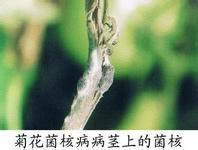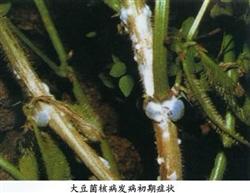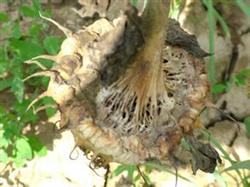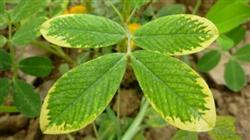Sclerotia Learn more about Sclerotia
-
Causes and control countermeasures of sclerotia in soybean

The main results were as follows: 1. The symptom field showed that the upper leaves of the plant became brown and died first, and the stem of the diseased plant continued to develop brown disease spots, resulting in white cotton flocculent mycelium and white particles, and then turned black to become sclerotia. In the stem of the longitudinal dissection plant, there were black cylindrical sclerotia arranged in turn. The diseased plant is gray-white after death, the hollow cortex of the stem is often rotten into hemp silk, and the sclerotia outside the diseased plant is easy to fall off. The disease spot on the pod is brown, it dies quickly and cannot bear fruit, and finally the whole pod is pale. Although the mildly diseased pod can be grained, the diseased grain is rotten or.
2019-01-16 -
Control methods of Sclerotinia sclerotiorum in Chrysanthemum

First, the symptoms of damage: waterlogged disease spots appeared in the middle and lower part of the stem at first, and then turned gray; under humid conditions, the disease part was soft rot, superficial white mildew layer, and in the later stage, the cortex of the diseased stem was moldy and fissured, and there were mouse dung-like black sclerotia in the endophy. sometimes sclerotia are also produced on the stem surface. Second, the morphological characteristics of pathogens: the pathogen is ascus.
2018-09-09 -
Occurrence and control of Sclerotinia sclerotiorum in soybean

Sclerotinia sclerotiorum is a common disease on soybean crops, which mainly causes stem rot, pale lesions, hollow stems and black sclerotia, which is easy to break. In the past two years, soybean Sclerotinia sclerotiorum has a tendency to increase year by year. Causes and characteristics: 1. The number of sclerotia in the field Sclerotinia sclerotiorum is a fungus.
2018-09-12 -
Integrated control of Sclerotinia sclerotiorum in coriander

Coriander, formerly known as coriander, alias: coriander, coriander, Latin name: Coriandrum sativum L. Annual or biennial strongly scented herbs of the family Umbelliferae and coriander, 20-100 cm tall. The root is fusiform, slender, with many slender branches. Columnar stem
2020-11-08 Coriander Sclerotinia sclerotiorum disease integrated control coriander original name -
Control methods of Sclerotinia sclerotiorum in bergamot

Symptoms: damage to fruits buried in sand during storage. Most of the diseased fruit first fell ill in the wound, began to be watery, light brown, rapidly expanded, soft rot, and finally rotted into a pile of mud, the disease produced a large number of black particles, that is, the pathogen.
2018-05-13 -
tulip rot sclerotinia

Tulip rot sclerotinia disease, pathogen belongs to semi-known fungus sclerotinia, mainly harm seedlings and bulbs. After the seedlings are infected, the leaflets die as soon as they are pulled out. Bulbs damaged, external scales occurred soft rot, and in the infected part and the surrounding soil surface appeared many white silk hypha, after the formation of many rapeseed sclerotia. After the formation of many sclerotia, sclerotia initially white, brown after. Pathogenesis of this disease depends on mycelium and sclerotia transmission, sclerotia winter in the soil, in high temperature and high humidity conditions, the disease occurs heavily. A, collection.
2019-01-16 -
Prevention and Control of White Silk Disease of Lily

Symptoms: the whole plant withered, the stem base wrapped around white fungal cords or rapeseed tea brown sclerotia, the affected area became brown and rotten. A large number of white fungal cords and tea-brown sclerotia can be seen on the soil surface. Pathogen: SclerotiumrolfsiiSacc. It is called Sclerotinia sclerotiorum, which belongs to the subphylum fungus. The hyphae were white silk-like, fan-like or radial expansion, and then gathered into fungal cords or entangled sclerotia. Sclerotia is like rapeseed, the initial white to yellow-white, and then become tea-brown, round, smooth surface. Route of transmission: ① bacteria
2019-01-16 -
Control methods of Sclerotinia sclerotiorum

[symptom] damage to leaves and bulbs is a common disease of hyacinth. The growth of the infected plants was blocked and the growth was retarded. The leaves of the diseased plants were grayish yellow, and with the development of the disease, the leaves gradually withered and easily detached from the bulb; the interior of the susceptible bulb changed color and rotted to varying degrees, resulting in white hyphae.
2019-03-04 -
Cultivation of Pleurotus ostreatus with bag material covered with soil

Tiger milk mushroom alias Poria cocos Pleurotus ostreatus, Japanese known as Nanyang Poria cocos, for both medicine and food mushrooms. Pleurotus ostreatus is mainly used as medicine in sclerotia, and the fruiting body contains 16%-45% protein, which is edible. Sclerotia contains glucose, fructose, galactose, maltose, cellobiose, palmitic acid, inositol, oleic acid and so on. Some countries and regions in Africa have a long tradition of edible and medicinal Pleurotus ostreatus. They cut the fruiting body of Pleurotus ostreatus into fine pieces, or remove the sclerotia from the sclerotia, boil them in salt water, slice or grind them, and cook them with other seasonings.
2019-01-11 -
Coriander planting: what are the hazards of Sclerotinia sclerotiorum?

What harm does coriander Sclerotinia sclerotiorum have? What causes Sclerotinia sclerotiorum of parsley? Also ask experienced netizens to help introduce the harm and causes of Sclerotinia sclerotiorum in coriander, which are listed below for netizens' reference. The harm of coriander Sclerotinia sclerotiorum: Sclerotinia sclerotiorum mainly harms the base of stem, followed by.
2018-07-18 -
How to control the white silk disease of tulips

White silk disease of tulip is a common disease that does great damage to tulips and often causes plant death. In breeding, attention should be paid to prevention and control. Symptoms: the whole plant withered, the stem base wrapped around white fungus or rapeseed tea brown sclerotia, the affected part became brown and rotten. A large number of white and tea-brown fungi can be seen on the soil surface.
2018-12-15 -
The prevention and control methods of hyacinth white silk disease and carnation white silk disease, what are the symptoms of white silk disease?

[symptoms] the whole plant withered, the stem base was wrapped around white fungal cords or rapeseed tea-brown sclerotia, and the affected part became brown and rotten. A large number of white fungal cords and tea-brown sclerotia can be seen on the soil surface. The disease occurs at the base of the stem near the soil surface and turns brown and rotten. Cut open the diseased stem tissue, starting from the outside with tea-brown or dark-brown rot to the center.
2019-03-04 -
Occurrence and control of Sclerotinia sclerotiorum in sunflower

With the accelerated pace of planting structure adjustment, the market demand for drug-eating sunflower seeds is increasing day by day. Sunflower is a kind of cash crop that is easy to manage, labor-saving and labor-saving. Due to extensive field management and continuous cropping for many years, many diseases are prevalent and aggravated year by year, directly resulting in sunflower yield.
2018-09-12 -
Four passes to control rice sheath blight

In recent years, sheath blight has become the most important disease of rice, and has four major characteristics: first, a wide range of occurrence. Second, there are very few varieties resistant to sheath blight. Third, the harm is becoming more and more serious, even causing lodging through the top. Fourth, the disease is first caused by the lower part of the rice plant, which is easy to ignore and miss the favorable opportunity for prevention and control. It is the key to strictly control the four hurdles in the prevention and control strategy. 1. Salvage sclerotia sheath blight mainly overwinters in rice fields in the form of sclerotia. When overwintering sclerotia pass through winter and spring to early rice transplanting, 60% to 70% of sclerotia can germinate. Most of the sclerotia are lighter than water and longer.
2019-01-16 -
White silk disease of tulip

Symptoms: the whole plant withered, the stem base wrapped around white fungus or rapeseed tea brown sclerotia, the affected part became brown and rotten. A large number of white fungi and tea-brown fungi can be seen on the soil surface. Pathogen: SclerotiumrolfsiiSacc. It is called neat micronucleus disease, which belongs to the subphylum of semiknowns. The hyphae were white silk-like, fan-like or radial expansion, and then gathered into fungal cords or entangled sclerotia. Sclerotia is like rapeseed, the initial white to yellow-white, and then become tea-brown, round, smooth surface. In addition, there are reports of Corticiumrolfsi
2019-01-16 -
Symptoms and Control of White Silk Disease of Tulip

Although it is not very difficult to cultivate tulips, they are still prone to disease if they are not cared for. White silk disease is one of the more common diseases of tulips, which will lead to the withering of the whole tulip plant. The editor will introduce the symptoms, etiology, prevention and treatment of this disease to you in detail.
2018-07-03 -
How does peanut sheath blight occur? How to prevent and cure?

How does peanut sheath blight occur? How to prevent and cure? (1) incidence regularity: peanut sheath blight is a disease caused by basidiomycetes. The young hyphae are colorless and yellowish brown when mature; they are branched, constricted obviously at the branches, and there is a septum not far from the branches. The hyphae on the surface of the diseased tissue can form sclerotia, sclerotia table.
2018-09-10 -
The latest control methods of Sclerotinia sclerotiorum in peanut

Peanut Sclerotinia sclerotiorum is a serious disease in the process of peanut planting, which mainly harms the root and root neck, as well as stems, leaves and fruits. This disease will generally reduce production by 10-20%, which is extremely harmful, so how to prevent and cure Sclerotinia sclerotiorum? Come and have a look with the editor.
2020-11-10 Latest peanut sclerotia disease control methods -
Where is the latest origin of Poria cocos?

Poria cocos is the dry sclerotia of Poria cocos, a pseudopore fungus, shaped like sweet potato, globular, light brown or dark brown outer skin, and pink or white inside. The ancients called Poria cocos a magic medicine at 04:00, because it has a wide range of effects, regardless of the four seasons, it is compatible with various drugs, no matter
2020-11-10 The latest Poria cocos origin where yes pseudo-lamellar pores mycaceae -
Where is the origin of Poria cocos?

Where is the origin of Poria cocos?
2018-07-05
